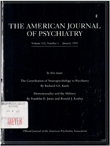Lifetime prevalence of panic states
Abstract
OBJECTIVE: Little is known about the prevalence of panic symptoms that do not meet criteria for panic disorder. This study was conducted to determine the prevalence of panic disorder, panic attacks, and limited- symptom attacks in the general population. METHOD: The authors identified a community-based sample of 1,683 randomly selected adults in 18 census tracts in San Antonio, Tex.; 1,306 of these subjects agreed to be interviewed with the Structured Clinical Interview for DSM- III. Subjects were classified as having panic disorder if they met DSM- III-R criteria, as having panic attacks if they had attacks of four or more panic symptoms but did not have panic disorder, and as having limited-symptom attacks if they had attacks of fewer than four symptoms but no full-blown panic attacks. RESULTS: The crude lifetime prevalence rates were 3.8% for panic disorder, 5.6% for panic attacks, and 2.2% for limited symptom attacks. Women had higher rates of panic disorder and panic attacks than men, but the difference between men and women was not statistically significant for limited-symptom attacks. No statistically significant differences in rates between Hispanic and either non-Hispanic white or black subjects were found. Non-Hispanic white subjects had higher rates of limited-symptom attacks than black subjects. CONCLUSIONS: The prevalence of limited-symptom attacks in this community-based study was 2.2%; black subjects had lower rates than non-Hispanic white subjects. Panic attacks appear to be at least as common as DSM-III-R panic disorder and, like panic disorder, are more common among women.
Access content
To read the fulltext, please use one of the options below to sign in or purchase access.- Personal login
- Institutional Login
- Sign in via OpenAthens
- Register for access
-
Please login/register if you wish to pair your device and check access availability.
Not a subscriber?
PsychiatryOnline subscription options offer access to the DSM-5 library, books, journals, CME, and patient resources. This all-in-one virtual library provides psychiatrists and mental health professionals with key resources for diagnosis, treatment, research, and professional development.
Need more help? PsychiatryOnline Customer Service may be reached by emailing [email protected] or by calling 800-368-5777 (in the U.S.) or 703-907-7322 (outside the U.S.).



